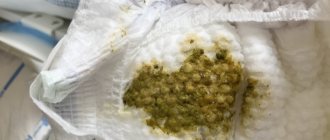What should a normal stool look like?
At different stages of development, the baby's stool changes from a liquid, unnatural color to a fraction characteristic of each person. Parents must be sure to monitor the frequency, consistency, color and presence of odor in the child’s discharge.
First three days of life
During this period of a little person’s life, the accumulation of remnants of amniotic fluid that entered the body at birth, intestinal epithelial cells, bile, mucus, etc. occurs in his intestines. Such feces are called original feces or meconium.
The discharge has a black, dark red or olive tone, a resinous structure and is odorless. Green stool in a newborn is not due to the bacterial nature of its formation. The appearance of discharge is the first sign of normal functioning of the gastrointestinal tract.
During the first two to three days, a breastfed baby’s body completely absorbs the mother’s colostrum, so feces are not formed.
Fourth – sixth days
The baby's intestinal system is developing due to changes in the composition of the nursing mother's milk and the formation of bacteria in the digestive tract.
The process occurs in two stages:
- Transitional feces
The baby's stool has the appearance of a paste, thick sour cream, the color is predominantly yellowish, with rare splashes of green (residual effects of meconium). The presence of a white mass and small amounts of stool with mucus in an infant is not a deviation. Changes in the appearance of feces occur under the influence of bacteria in the gastrointestinal tract.
- Mature feces
The discharge takes on a dark green color with a transitional gray tint, and has a porridge-like consistency. Initially, the frequency of bowel movements is about ten times a day, and as you get used to breast milk, the frequency of bowel movements decreases to one or two times over three to seven days.
This is due to the complete absorption of the beneficial substances of breast milk in the infant’s gastrointestinal tract. It is necessary to strictly monitor meconium in the stool: if its presence in the stool is observed on the fifth day, you should consult a doctor. Artificial feeding can affect the structure of stool.
Second week of life – 28 days
The baby's stool takes on a light brown, mustard color. The consistency of the mass is mushy. Green, liquid stool in a baby or constipation indicate the occurrence of abnormalities.
First months
At the stage of feeding the baby with breast milk, the stool is normally mature. The waste products of a baby can be light brown, grayish and even green. The feces of a month-old baby on breastfeeding should be of medium density: neither liquid nor solid.
At 3 years of age, the presence of food inclusions in the stool is allowed, and the color directly depends on the food the child eats.
When should green stool alert parents?
When parents detect green feces in their baby, they should carefully monitor the general condition of the baby.
If they find any of the symptoms listed below in the baby, then this is a reason to definitely consult a doctor and carry out the necessary examination and treatment.
Useful: How to treat thrush in a child's mouth?
Alarming symptoms:
- green, watery, foamy discharge;
- stool with a frequency of more than 12-15 times a day;
- mixed with mucus and streaked with blood;
- with a foul, sour or putrid odor;
- you notice severe irritation on the skin of the baby’s bottom after contact with such a stool;
- the baby is worried about bloating and intestinal colic;
- there is moodiness or lethargy;
- you notice a decrease in your baby’s appetite;
- there is insufficient weight gain or even weight loss.
Causes of green stool in infants
Green stool in a baby is not always a cause for concern. Let us highlight the main factors that can cause “herbal” feces to appear in an infant in the first months of his life.
Causes of green stool
Sources of unnatural stool color in a baby:
- composition of mother's breast milk;
- use of complementary foods;
- deviation of the baby’s immunity;
- age-related changes.
When breastfeeding
The reasons for the appearance of greenish stool in a child during breastfeeding can be:
- mother’s food range: if the diet is rich in green vegetables and herbs;
- intoxication of the nurse's body due to poisoning;
- exposure to medications: for example, taking antibacterial agents;
- lack of nutrition: limited amount of breast milk, early refusal of breastfeeding. The feces become liquid and foamy, and the baby’s weight drops.
With artificial and mixed feeding
A green tint to the stool of a mixed-fed baby occurs depending on the composition of complementary foods:
- artificial mixture is enriched with iron;
- food causes an imbalance in the child’s body, allergic reactions occur;
- incorrectly selected or incorrectly prepared food;
- dysbacteriosis, immune system failure: complex components of complementary foods complicate the functioning of the gastrointestinal tract.
General sources
The basic factors for the manifestation of green stool in infants are:
- chemical oxidation processes under the influence of oxygen;
- inflammatory foci in the infant’s gastrointestinal tract due to difficult childbirth;
- natural removal of bilirubin (bile pigment) from the body;
- additional nutrition with a mixture with a high concentration of sugars and iron;
- lactose intolerance, bacterial imbalance;
- the impact of diseases, poor functioning of the endocrine system, malfunction of the gastrointestinal tract.
Dysbacteriosis
When the balance of vital bacteria is disturbed, the natural functioning of the intestines is disrupted in the baby’s body. The condition is characterized by an increase in body temperature, disruption of the process of excretion of feces, and psycho-emotional disorders.
If the course of the disease is favorable, the baby’s immunity copes with it on its own. If the disorder lasts, you will need to take foods enriched with bacteria.
Lactase deficiency
The condition is expressed by difficulty in processing milk sugar due to a small amount of lactase and, as a consequence, the development of dysbacteriosis. The stool is liquid, greenish-yellow with a pungent odor and foamy consistency.
The deviation goes away on its own after nine months of the baby’s life, less often up to a year. Sometimes there is a hereditary disorder. To restore the baby’s stool, it is recommended to adjust the diet of the mother producing breastfeeding, as well as the use of therapy to replenish lactase in a child at 2 years old.
By month
The stages of development of the baby’s body directly affect the appearance of green color in the stool:
- 1 month: green stool in a newborn is the norm, a consequence of the gastrointestinal tract adapting to nutrition, if the process is not accompanied by third-party symptoms;
- 2 month: dysbacteriosis is possible due to the unstable state of the intestines of a two-month-old baby;
- 3 month: due to slow development, green stool in a 3 month old baby may be an indicator of normality;
- 4 months: a common cause of green stool is untimely complementary feeding;
- 5th month: the color of the stool in a five-month-old baby depends on the administration of additional nutrition;
- 6-7 months: the baby eliminates discomfort from emerging teeth by biting foreign objects, so green stool in the child will become an indicator of disorder or infection;
- 8-10 months: bilirubin no longer affects the color of stool, discharge depends on the composition of complementary foods;
- 11-12 months: Green stool in a 1 year old baby is an indicator of food intake or an allergic reaction.
Green stool as one of the symptoms of the disease
Parents should take immediate action if their child's green stool is accompanied by the following symptoms:
- decreased mobility, drowsiness, moodiness;
- loss of appetite;
- foamy consistency of stool in infants,
- a sharp putrid odor of feces in a one-year-old child, green foam bowel movements;
- Green, liquid stool is passed out very often in infants;
- entry of blood as a cause of gastrointestinal damage;
- incessant diarrhea in a one and a half year old child;
- vomiting, frequent regurgitation of food;
- the child has green, loose stools with large quantities of mucus;
- flatulence, colic;
- skin rashes.
Hard green stool
Constipation in a baby who is fed mother's milk is a rare occurrence. Most often, this problem occurs in artificial babies. Hard, dark green stool in a formula-fed baby is a reason to pay attention to its nutrition. It is advisable to consult a pediatrician; perhaps he will recommend changing the formula.
Feces with such characteristics may appear after taking antibacterial drugs. The reason is changes in the composition of the intestinal microflora under the influence of such drugs. This problem can arise even if the drugs were taken not by the child, but by the nursing mother. Other means can cause a similar violation:
- antifungal;
- hormonal;
- anti-inflammatory;
- astringents.
Malnutrition can also affect the color of stool. This most often happens if several feedings are replaced with formula milk. Lack of breast milk can affect the color of stools, making them appear green.
What does the shade and consistency of green stool tell us?
Based on the degree of color saturation and density of green feces, one can judge the reasons for the changes:
- deep green: normal; depends on the food range; dark green, loose stools in infants may be a consequence of lactase deficiency;
- light green, yellow-green: normal indicator; impaired lactation or lack of breast milk with hind fat milk;
- black-green: typical only for newborns, in other cases it is a malfunction of the gastrointestinal tract, a nutritional error;
- deep green: lack of hindmilk, food pigmentation;
- green foam: lactase deficiency, low fat content of milk during breastfeeding;
- mushy: normal indicator;
- green stool with mucus, watery, liquid, too hard stool: deviation of the gastrointestinal tract, development of the disease.
The reason for panic among parents should be the general deterioration of the baby’s condition.
Treatment of gastrointestinal tract in children
After the doctor examines the results of the tests, he can diagnose the baby. Depending on the development of a particular pathology, various medications can be used. It is worth noting that most problems with the gastrointestinal tract can be solved with the help of a special diet and taking safe medications. But more severe conditions require hospitalization.
Medicines
If the stool is green or the child begins to be bothered by various problems with the digestive system, then you should immediately visit a doctor. Ignoring the symptoms will certainly lead to serious consequences. In such cases, medications are used to help normalize metabolic processes in the child’s body. Below are the most effective ones.
Table. Drugs to improve digestion in infants.
| Name of the drug, photo | Description |
| Hilak-forte | An effective medicine that comes in the form of drops. Suitable for infants and slightly older children. This drug is incompatible with fermented milk products, which the doctor must inform parents about when prescribing. |
| Plantex | It is used in the treatment of various pathological disorders of the gastrointestinal tract, as well as for their prevention. Most often, the drug is prescribed to infants, but older than 14 days. Great for transitioning your baby from breast milk to formula. |
| Primadophilus | A common dietary supplement (dietary supplement) used to normalize the functioning of the gastrointestinal tract. With regular use, the product helps improve intestinal microflora. It has no contraindications, so it is often prescribed to children. |
| Enterofuril | An antimicrobial drug with bactericidal and bacteriological properties. Used in medicine in the treatment of acute intestinal infections and other pathologies of the gastrointestinal tract. Helps cope with various types of diarrhea. Helps normalize intestinal microflora. |
| Enterosgel | An excellent detoxifying medicinal product used in the treatment of intestinal disorders, infectious diseases, diarrhea, gastritis and other disorders of the digestive system. The action of the drug is to neutralize harmful substances that are in the stomach. Excellent for dysbiosis in children. |
| Normobakt | Another product that contains beneficial bacteria. This is a dietary supplement available in powder form. Used for various gastrointestinal disorders (dysbacteriosis, prolonged diarrhea, metabolic disorders). Another dietary supplement is actively used in the treatment of infectious diseases affecting the organs of the digestive system. |
If the stool has a characteristic green color in a baby who is fed formula or breast milk, this phenomenon can act as both an indicator of normality and a sign of a serious illness. What exactly the change in color indicates in a particular case can only be said by a doctor after laboratory tests. You cannot judge the baby’s health only by the color of the stool, because an integrated approach is important here, which consists of taking tests, interviewing parents and examining the child with a doctor. Only on the basis of all the information can a conclusion be drawn.
Stool test results
What to do if you have green stools?
If your stool appears green, the following actions are recommended:
- Ensure that the baby is properly attached to the breast, allow him to get enough and complete breastfeeding on his own.
- Make breastfeeding regular, depending on the body's needs.
- Control your diet during breastfeeding, avoid artificial additives and exotic foods.
- Treat the baby's intestinal dysfunction under the supervision of a doctor.
- Don't worry if your stools turn green after taking Smecta.
- Thoroughly study the composition of artificial complementary foods, ensure optimal selection for the baby’s body (for example, use NAN mixtures).
- Green stools without accompanying warning signs are normal and do not require intervention.
- Use of additional nutrition in due time.
- Dr. Komarovsky can give an online consultation on his website.
- The frequency of green stools in combination with alarming symptoms is a necessity for seeking medical help.
Green stool in a newborn during breastfeeding is not always a deviation. If your child is developing normally, cheerful and active, there is no need to worry once again about why the child has green stool and tirelessly torment the child with visits to the doctor.
Control your diet during breastfeeding, provide your children with proper care, monitor their behavior, and then there will be much less cause for alarm.
Prevention
To avoid the appearance of green stool in a bottle-fed baby, you should follow a number of simple tips:
- maintain hygiene of the utensils from which the baby regularly eats;
- select a high-quality formula that is suitable for the child’s age and other indications (susceptibility to allergies, lactase deficiency, loose stools);
- do not transfer the baby from one mixture to another unless absolutely necessary;
- introduce complementary foods no earlier than the due date, so as not to provoke disorders of the digestive system;
- monitor the child’s body’s reaction to new foods in the diet;
- undergo regular preventive examinations with doctors.
On a note! It is better to prevent any disease than to treat it for a long time. Therefore, when green stool appears in a one-month or two-month-old baby who is being bottle-fed, it should be shown to the doctor, even for preventive purposes. At this age, the digestive system is not complete, the microflora is not fully populated, so any errors can cause health problems for the baby.
If an incomprehensible color of stool appears in an artificial child, you should not panic; perhaps the change in the color of the stool is caused by reasons that do not pose a danger. If the baby sleeps soundly, does not twist his legs, does not refuse to eat, and his body temperature with loose stools is normal, you need to monitor his well-being. In the absence of alarming symptoms, it is enough to eliminate dietary errors, walk in the fresh air and maintain hygiene. More serious cases require medical intervention to avoid dehydration and the development of dangerous consequences for the baby.











